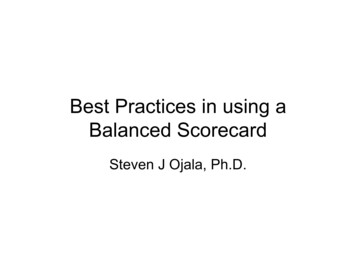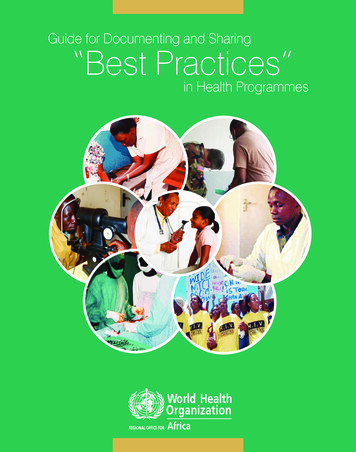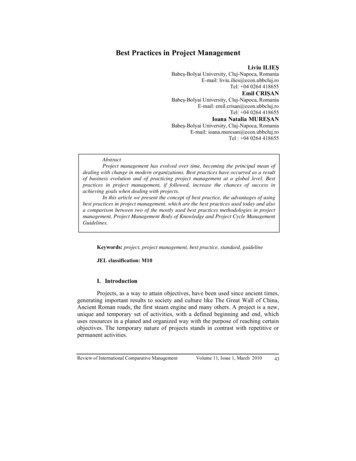
Transcription
Best Practices in using aBalanced ScorecardSteven J Ojala, Ph.D.
The Balanced Scorecard What is it?Definition:The Balanced Scorecard is amanagement tool that providesstakeholders with a comprehensivemeasure of how the organization isprogressing towards the achievement ofits strategic goals.
The Balanced Scorecard Balances financial and non-financial measures Balances short and long-term measures Balances performance drivers (leading indicators) with outcomemeasures (lagging indicators) Should contain just enough data to give a complete picture oforganizational performance and no more! Leads to strategic focus and organizational alignment.
The Balanced ScorecardWhy do it? To achieve strategic objectives. To provide quality with fewer resources. To eliminate non-value added efforts. To align customer priorities and expectations withthe customer. To track progress. To evaluate process changes. To continually improve. To increase accountability
The Strategy FocusedOrganization Mission – What we do Vision – What we aspire to be Strategies – How we accomplish our goals Measures – Indicators of our progress
The Strategy FocusedOrganizationThe Five Principles Translate the strategy to operational terms. Align the organization to the strategy Make strategy everyone’s job. Make strategy a continual process. Mobilize change through executive leadership
The Balanced Scorecard Activity Based CostingEconomic Value AddedForecastingBenchmarkingMarket ResearchBest PracticesSix SigmaStatistical Process ControlReengineeringISO 9000, 13485Total QualityManagementEmpowermentLearning OrganizationSelf-Directed WorkTeamsChange Management
The Balanced ScorecardHistory First created in 1987 at Analog Devices Bob Kaplan published HBR articles in 1992 “The Balance Scorecard” book published in1996 Adopted by many companies in the 90’s More popular in Europe Popular with Government organizations Widely used in Education
The Balanced Scorecard
The Balanced ScorecardFinancial Measures Funding/cost Magnitude Resources produced/unit cost Percent change from last period Risk assessment Cost / BenefitDeming #4:Cease doing businesson price tag alone.
The Balanced ScorecardCustomer Measures Customer/potential customer groups(market segments) aligned withproducts & services used Satisfaction: prompt, courteous, expert Complaint tracking and trending These are leading indicators:dissatisfied customers will quickly findother suppliers
The Balanced ScorecardProcess Measures How well are internalprocesses running? Do products/servicesconform to customerrequirements:dependable, accurate,complete Designed by those whoknow processes mostintimately Mission-oriented andfocused on processimprovementDeming #3:Cease dependenceon mass inspection.Deming #5:Continual improvementof process.Deming #11:Eliminatenumerical quotas.
The Balanced ScorecardLearning/Growth(People) Measures In a learningorganization, peopleare the main resource Individual andinstitutional learning:hiring, training,technical tools,mentoring anddevelopment CommunicationDeming #6:Institute trainingon the job.Deming #7:Institute leadership.Deming #13:Institute a programof self-improvement.
Deming’s 14 Points1. Constancy of Purpose2. Adopt the newphilosophy3. Cease dependence onmass inspection4. Cease doing businesson price tag alone5. Continualimprovement ofprocess6. Institute training on thejob7. Institute leadership8. Drive out fear9. Break down barriersbetween departments10. Eliminate slogans,exhortations, andtargets11. Eliminate numericalquotas12. Allow pride inworkmanship13. Institute a program ofself-improvement14. Do it
The Balanced Scorecard Part of a spectrum of QualityImprovement activities–––––Starting with DemingThrough Quality Circles and TQMPhil Crosby: “Quality College”Tom Peters: “In Search of Excellence”Ending with Six Sigma and Lean Today All focused on the customer, processimprovement and part of continuousimprovement efforts
The Balanced ScorecardAn Example
Balanced Scorecard ExampleFINANCIALWe deliver tremendous medical value in aresponsible, predictable mannerKEY STRATEGIES:Increase revenue through innovativedevice technologyMetric: PEOPLECreating device leadership using ourmost valuable assetsKEY STRATEGIES:Quarterly sales in devicesDeliver devices with minimal resources(headcount and dollars)Metric:Total headcount and dollarsAccurately predict financial expensesMetric:Adherence to Internal and External expensePlan and Capital Spend Plan.Provide devices that are profitable and consistentwith corporate FMC targetsMetric: Adherence to Internal and External expense Planand Capital Spend PlanProvide device technology with the lowest totalmanufacturing cost to our customersMetric:COPS by product – supplier/site, depreciation, overheadHire, develop, and maintainappropriate resources to achievemission, vision, strategic intentand objectives.Metrics:1) % Training current2) % Development plancompletionMaintain a work environment thatis attractive to members of theteam.Metrics:1) Employee Satisfaction (quarterly survey)2) % positions 3 yrs in role3) Safety Record
The Balanced ScorecardCUSTOMERMeet both external and internal customerneeds with the best products in theirclassKEY STRATEGIES:Provide the best device in its class tomaximize customer satisfaction andmarket share. “Perception of poorquality will never be the reason acustomer does not use our device”.METRICS: Post launch survey results(customer preference andperception of quality)Complaints per Million formarketed productsAverage days for complaintresponse to customer.% on time in fullCustomer satisfaction SixSigma resultsBUSINESS PROCESSCreate and deliver superior devices bymeeting unmet customer needs .KEY STRATEGIES:Create and deliver superior devicesby integrating unmet customerneeds with innovativetechnology.METRICS: # of patents submitted andapproved# of projects on schedule# of New ProductIntroductionsAverage Cycle times# of manufacturingimprovementsYield improvements# of Non-conformancesQuality backlog, nonconformances per lot, %Japan defects.
The Balanced Scorecard The Balance Scorecard is a FeedbackTool It is not a Strategy or Quality program Think of it as a “Dashboard” Should be done in addition to the otherQuality Improvement Initiatives:– Six-Sigma– Lean– Design for Six-Sigma
The Balanced Scorecard
The Balanced Scorecard Learning/Growth (People) Measures In a learning organization, people are the main resource Individual and institutional learning: hiring, training, technical tools, mentoring and development Communication Deming #13: Institute a program of self-improvement. Deming #7: Institute leadership. Deming #6: Institute .











